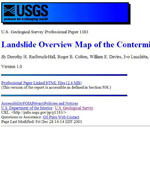The accompanying landslide overview map of the conterminous United States is one of a series of National Environmental Overview Maps that summarize geologic, hydrogeologic, and topographic data essential to the assessment of national environmental problems. The map delineates areas where large numbers of landslides exist and areas which are susceptible to landsliding. It was prepared by evaluating the geologic map of the United States and classifying the geologic units according to high, medium, or low landslide incidence (number) and high, medium, or low susceptibility to landsliding.
Rock types, structures, topography, precipitation, landslide type, and landslide incidence are mentioned for each physical subdivision of the United States. The differences in slope stability between the Colorado Plateau, the Appalachian Highlands, the Coast Ranges of California, and the Southern Rocky Mountains are compared in detail, to illustrate the influence of various natural factors on the types of landsliding that occur in regions having different physical conditions. These four mountainous regions are among the most landslide-prone areas in the United States.
The Colorado Plateau is a deformed platform where interbedded sedimentary rocks of varied lithologic properties have been gently warped and deeply eroded. The rocks are extensively fractured. Regional fracture systems, joints associated with individual geologic structures, and joints parallel to topographic surfaces, such as cliff faces, greatly influence slope stability. Detached blocks at the edges of mesas, as well as columns, arched recesses, and many natural arches on the Colorado Plateau, were formed wholly or in part by mass movement.
In the Appalachian Highlands, earth flows, debris flows, and debris avalanches predominate in weathered bedrock and colluvium. Damaging debris avalanches result when persistent steady rainfall is followed by a sudden heavy downpour. Landsliding in unweathered bedrock is controlled locally by joint systems similar to those on the Colorado Plateau. In some places, outward gravitational movement of valley walls due to stress release has formed anticlines and caused thrusting in the center of valleys.
In the Coast Ranges of California, slopes are steep, and rocks are varied and extensively deformed. One of the most slide-prone terrains of the Coast Ranges is the tectonic melange of the Franciscan assemblage, on which huge masses of debris are moving slowly downslope. In southern California, debris flows generated by soil slips are particularly damaging. Similar flows are common in poorly consolidated Tertiary rocks of the central part of the State. Like the debris avalanches of the Appalachian Highlands, the flows form during intense rainfall after previous steady rain.
The Southern Rocky Mountains are complex in rock type and climate, so that the landslides there are also complex. Slides range from rock-falls at one extreme to slumps and debris flows at the other. They include ?sackungen,? which are distinguished by ridgetop grabens associated with uphill-facing scarps on ridge sides, both features of gravitational origin. Extensive regional joint patterns have not been recognized, and shallow soil slips are only a minor hazard.


